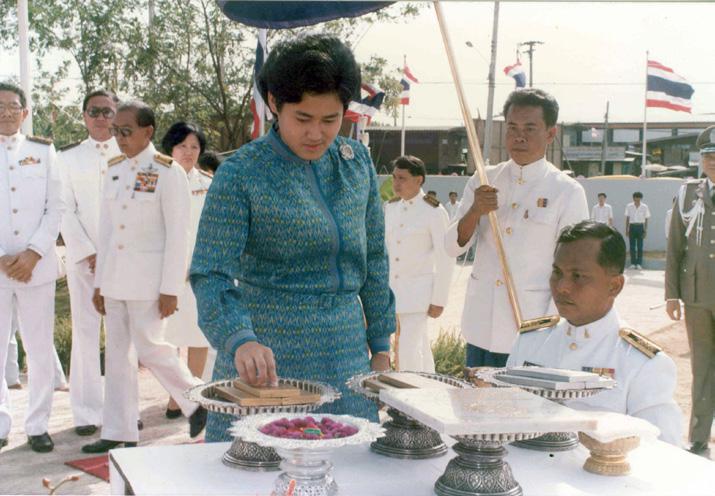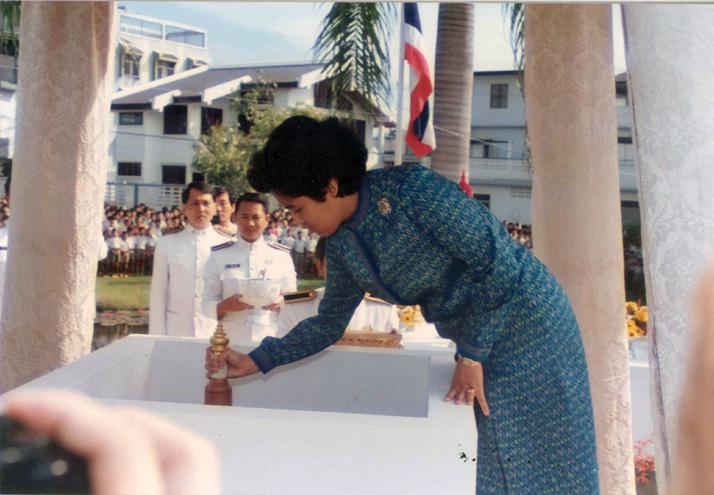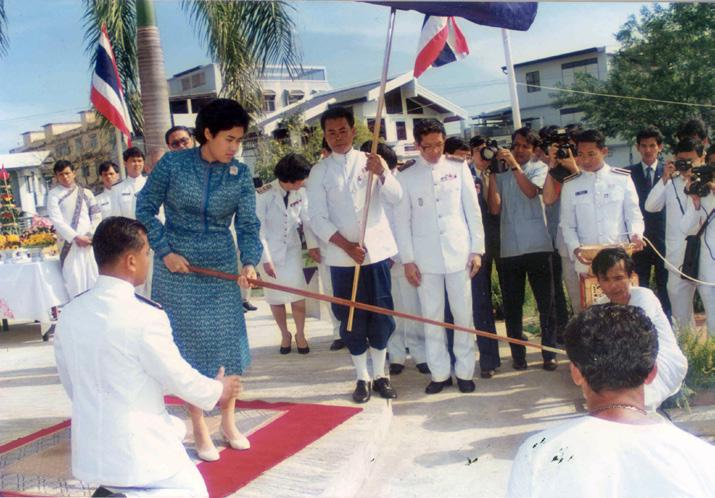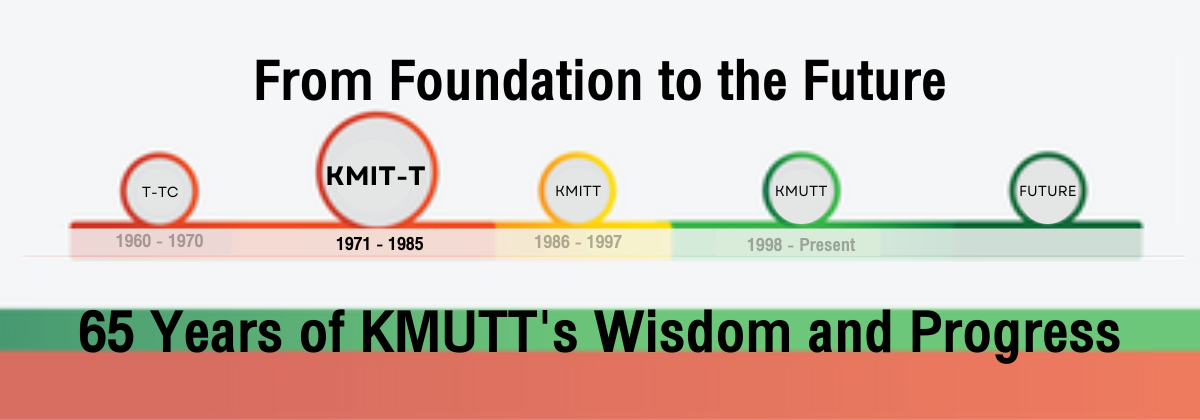
A Step Towards Value
Period 2: King Mongkut's Institute of Technology Thonburi (1971-1985)
Elevating to a technological institution while preserving its unique focus on practical work, it plays a key role in driving research and innovation.
1971
On February 4, 1971, the House of Representatives voted to approve the principles of the King Mongkut’s Institute of Technology Act, B.E. 2514. The Act was published in the Royal Gazette, Special Edition, Volume 88, Issue 43. The main goal of the Act was to produce vocational education teachers at the degree level.
On August 2, 1971, the first meeting of the King Mongkut’s Institute of Technology Council was held.
In September 1971, the first mailbox for the college was installed.
On November 5, 1971, the Institute Council decided to merge the College of Construction Technology from the Department of Vocational Education into King Mongkut’s Institute of Technology. It was established as the Faculty of Architecture, starting from the fiscal year 1973. As a result, the Institute’s management committee decided to stop admitting students to the Architecture program at King Mongkut’s Institute of Technology Thonburi from the 1972 academic year onward.
On November 17, 1971, the Revolutionary Council (led by General Thanom Kittikachorn, who also served as the Prime Minister) took control of the country. They issued an order appointing the Permanent Secretary of the Ministry as the head of the Ministry, responsible for overseeing its affairs. Mr. Boonthin Attakorn, the Permanent Secretary, exercised the powers of the Minister of Education, and thus became the second Chairman of the Institute Council. On December 22, 1971, His Majesty the King issued a royal decree appointing Mr. Phongsak Worasantaros as the new President of the Institute.
On December 22, 1971:
- His Majesty the King issued a royal decree appointing Mr. Phongsak Worasantaros as the President of the Institute.
- The Institute requested royal permission to use the “Phra Mahamongkut” (Royal Crown) as its official emblem. The emblem design was based on a new design, which was inspired by the emblem of King Rama IV. Royal permission was granted on December 24, 1971.
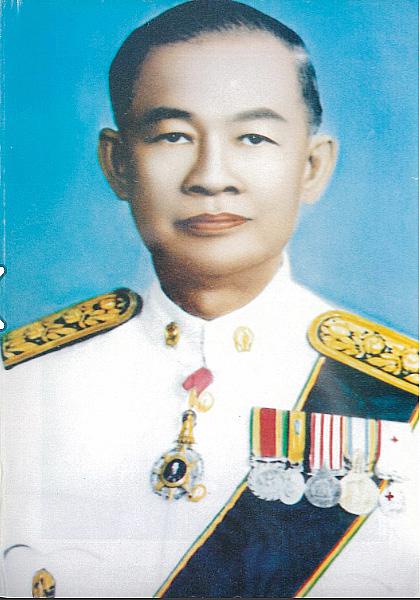
Professor Boonthin Attakorn
1972
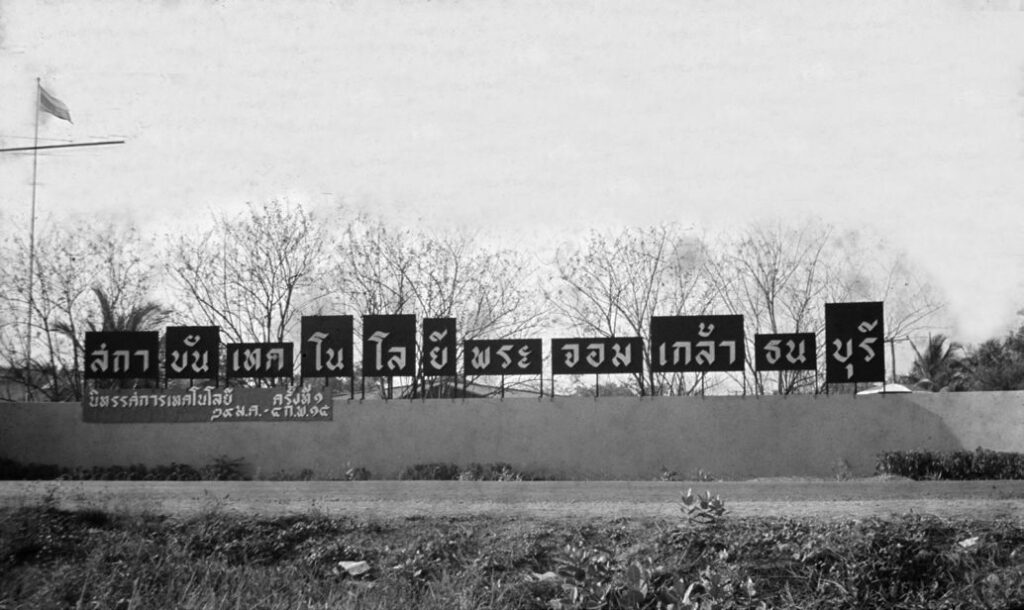
The Asia Foundation supported the event with a donation of 15,000 baht. Various embassies sent posters for display, and over 10 commercial vendors participated in the exhibition. Students from different schools competed in a science quiz, drawing a large crowd. Approximately 19,000 people attended the event. Rear Admiral Chalee Sinthusophon, an esteemed board member of the Institute, visited the exhibition personally and later praised the event during a meeting of the Institute Council, in the presence of the Minister of Education and the President.
From January 29 to February 4, 1972, the students of King Mongkut’s Institute of Technology Thonburi organized the first Technology Exhibition. The event was chaired by Mr. Kasem Sothiwat, Chairman of the Organizing Committee, with Dr. Paiboon Hangsapruk, the Vice President, serving as the Chairman of the Advisory Committee. The exhibition, held on the Institute’s premises, showcased the technological achievements of students from all departments and aimed to promote advancements in science and technology to the public.
On March 1, 1972, the UNDP (United Nations Development Programme) launched its third assistance project for the Faculty of Industrial Education and Science at King Mongkut’s Institute of Technology Thonburi. The project was titled Technical Teacher Training Programme, King Mongkut’s Institute of Technology Thonburi (Phase II), SF. THA. 72/005. The nature of the assistance was similar to that of the previous projects, with a duration of 3.5 years and a total value of 735,790 US dollars. The team of experts involved in this project included:
1. Mr. H.N.C. Stam Chief Technical Adviser (Netherlands)
2. Mr. I. Davies Production Engineering Expert
3. Mr. D.P. Morrion Electrical Engineering Expert
4. Mr. A. Stromberg Civil Engineering Expert
5. Mr. D.E. Alexander Mechanical Engineering Expert
6. Mr. John McGreal Expert in Principles and Methods of Education
7. Mr. D. Blumel Associate Expert in Production of Technical Learning Materials
8. Mr. P. Alexandre Electrical Engineering Expert
9. Mr. H. Bange Civil Engineering Expert
10. Mr. C.E. Strand Associate Expert in Mechanical Engineering Teaching
– The scholarship recipients under the THA 72 project included:
1. Mr. Bunterng Suwantrakul – Studied in the United Kingdom
2. Mr. Chayanon Srisuphinanont – Studied in the United States
3. Mr. Kachornsak Kanthapanit – Studied in the United States
4. Mr. Sumpan Harnchalair – Studied in the United States
5. Mr. Pisit Awatchanakorn – Studied in the United States
6. Mr. Chusak Pliangphu – Studied in the United States
On March 14, 1972, the Institute Council announced the implementation of the Regulations on the Collection of Educational Maintenance Fees and Tuition Fees, B.E. 2515 (with amendments on July 17, 1972).
In the 1972 academic year, the Department of Language and Social Studies revised its curriculum and adopted an Intensive approach to teaching English.
On June 5, 1972, the Institute Council set new standards for academic assessments. It was determined that the departmental committees would review the results of academic assessments at all levels and for every semester. The Deans were assigned the responsibility to approve the results of assessments within their respective faculties. In cases of issues or disputes, the President of the Institute would have the final decision-making authority.
On June 6, 1972, the Office of the Civil Service Commission (OCSC) officially recognized the Bachelor of Engineering degrees in Civil Engineering, Electrical Power, Electronics, Mechanical Engineering, and Industrial Engineering from King Mongkut’s Institute of Technology Thonburi. The degrees were classified as qualifications that could allow graduates to be appointed to civil service positions, but not higher than the second-level, Grade 1, with a salary of 1,250 baht, in accordance with Clause 6 (2) of the OCSC regulations, No. 622 (B.E. 2513).
On June 9, 1972, the Institute Council of King Mongkut’s Institute of Technology approved the hiring of a doctor, Dr. Kudan Patmasut, to provide healthcare services to students for the first time.
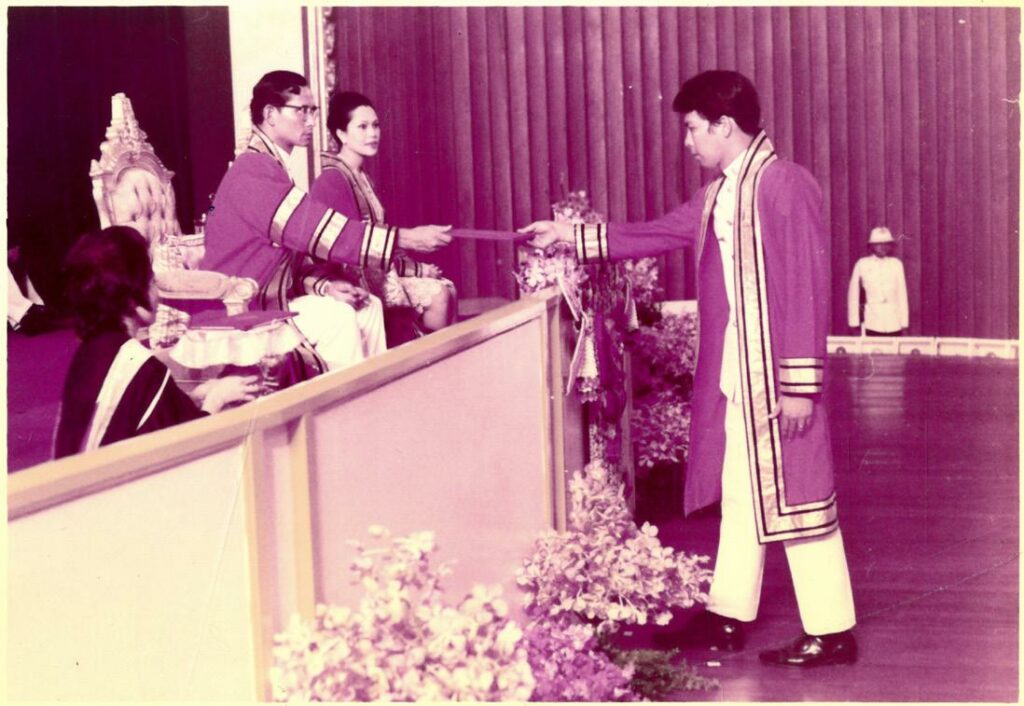
On December 19, 1972, His Majesty the King issued a royal decree appointing Mr. Apai Chanthawimon as the Minister of Education. Mr. Apai Chanthawimon became the third Chairman of the Institute Council of King Mongkut’s Institute of Technology.
On October 18, 1972, King Mongkut’s Institute of Technology conferred honorary Doctoral Degrees in Engineering and Architecture upon His Majesty the King and Her Majesty the Queen. The first-ever commencement ceremony for conferring degrees was also held at the Teachers’ Council Auditorium, Ministry of Education.
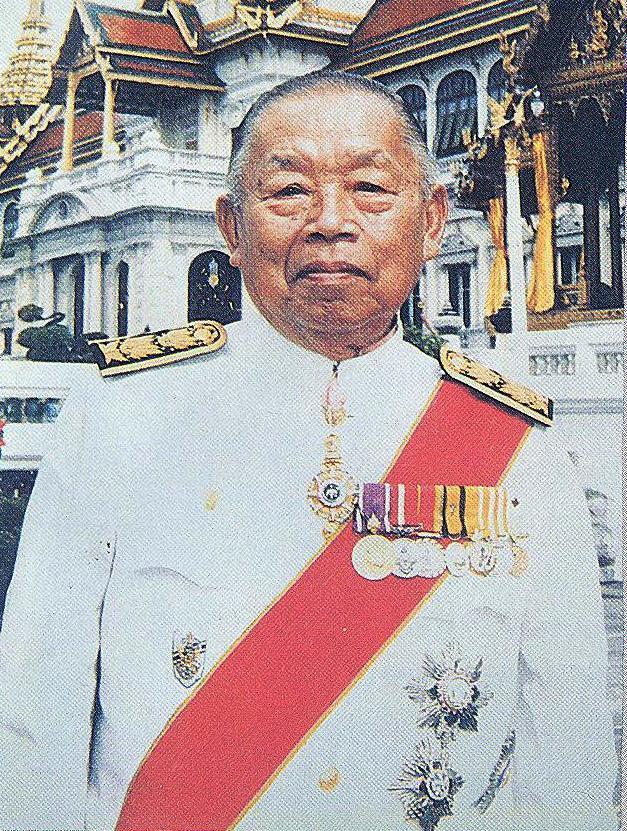
Professor Apai Chanthawimon
1973
On July 3, 1973, His Majesty the King issued a royal decree appointing Major General Paramet Adireksarn and Professor Prasert Na Nakhon as esteemed members of the Institute Council.
On October 14, 1973, a political crisis occurred. Field Marshal Thanom Kittikachorn, the Prime Minister, respectfully submitted his resignation. His Majesty the King graciously appointed Mr. Sanya Dharmasakti as the new Prime Minister and reappointed Mr. Apai Chanthawimon as the Minister of Education for another term.
The commencement ceremony, originally scheduled for October 25, 1973, had to be postponed due to the unfinished reorganization of the administrative divisions within the Institute. The members of the Management Committee of Thonburi Technical College, who had been serving continuously, were almost the same as the Academic Committee members. The Vice President therefore assigned the Academic Committee to continue its duties as the sole body in charge.
Starting from November 5, 1973, the committee consisted of:
1. Dr. Hris Suttabut – Chairman
2. Dr. Preeda Vibulsawasdi – Committee Member
3. Dr. Worakrit Woraphamorn – Committee Member
4. Dr. Kritsanapong Keeratikorn – Committee Member
5. Mr. Sommai Seemakul – Committee Member
6. Mrs. Khawjai Boonyasing – Committee Member
7. Mrs. Nanta Kowong – Committee Member
8. Mr. Phairoj Teeranathanakul – Committee Member
9. Mr. Uthai Phaephu – Committee Member
10. Dr. Nara Khomnamool – Committee Member
The government adopted a policy to place higher education institutions that have the legal authority to confer degrees in their respective fields under the supervision of the Ministry of University Affairs. As a result, the Cabinet issued a decree in November 1973 to transfer King Mongkut’s Institute of Technology to become a government agency under the Ministry of University Affairs. This also included an amendment to the Revolutionary Council Announcement No. 216, dated September 29, 1972.
In December 1973, students from “Maejo Agricultural College” in Chiang Mai Province (which later became the Agricultural Technology Institute, Maejo Agricultural Technology Institute, and eventually Maejo University) requested to join King Mongkut’s Institute of Technology Thonburi. The Academic Council recommended that the matter be proposed to the Ministry of University Affairs for the establishment of a new institution.
1974
On January 11, 1974, a group of vocational education students organized a march to demand the opportunity to continue their education up to the degree level. They requested that King Mongkut’s Institute of Technology be transferred back under the Ministry of Education, as it had been previously, and that the Institute accept students who had completed M.S. 6 (the equivalent of high school) for the academic year 1974. The Prime Minister accepted their proposal.
The Student Council of King Mongkut’s Institute of Technology Thonburi submitted a letter of objection the following day. The Institute’s faculty members convened a meeting and passed a resolution to form a 17-member committee to draft a formal petition to the Prime Minister. The committee proposed that the decision regarding this matter should be entrusted to the Institute Council, as outlined in the King Mongkut’s Institute of Technology Act B.E. 2514. They also provided explanations on various issues related to the proposal.
In the 1974 academic year, King Mongkut’s Institute of Technology Thonburi introduced a Bachelor’s degree program in Chemical Engineering within the Faculty of Engineering. The first cohort consisted of only 31 students.
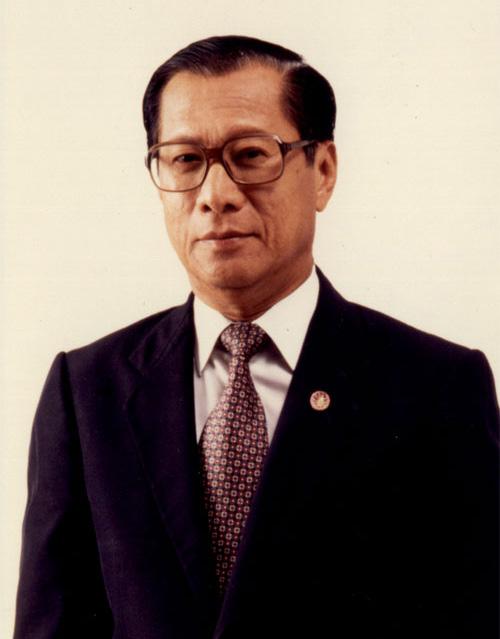
Professor Kasem Suwannakul
On June 28, 1974, the Royal Gazette (Volume 91, Issue 112, Special Edition) published the announcement to transfer King Mongkut’s Institute of Technology from the Ministry of Education to the Ministry of University Affairs, making it a government agency under the Ministry. A royal decree was issued appointing Professor Kasem Suwannakul, the Minister of the Ministry of University Affairs, as the fourth Chairman of the Institute Council.
Prior to this, a royal decree had already appointed Major General Paramet Adireksarn and Professor Prasert Na Nakhon as esteemed members of the Institute Council, starting on July 3, 1973.
On July 24, 1974, the Institute Council approved the introduction of a Master of Engineering (M.Eng.) program in Mechanical Engineering, to be offered starting in the 1975 academic year, as proposed by the Faculty of Engineering, Thonburi.
On August 21, 1974, the Institute announced the King Mongkut’s Institute of Technology Regulations on Academic Assessment for the Graduate School, B.E. 2517 (1974).
On September 20, 1974, the transportation route to the Institute was fully paved with asphalt, but the two existing bus routes, 84 and 88, were still insufficient to accommodate the growing number of passengers. As a result, King Mongkut’s Institute of Technology Thonburi requested the Department of Land Transport to extend bus routes 75 (Hua Lamphong – Chettuphon Commercial College) and 87 (Nang Leung Horse Racecourse – Chettuphon Commercial College) to reach the Institute.
The Transportation Control Committee met on September 20, 1974, and approved the extension of bus route 87 to pass by the Institute, continuing to its final destination at Suan Thonburi Rom.
On October 19, 1974, the Institute held its second commencement ceremony at the new building at Suan Amporn. Dr. Jang Rattanarat and Professor Phongsak Worasutnaroros received honorary Doctorates in Engineering.
On October 20, 1974, King Mongkut’s Institute of Technology Thonburi presented a royal “Kathin” ceremony at Wat Phra Borommathat Worawihan in Chai Nat Province. Additionally, students from the Civil Engineering Department, specializing in Structural Engineering, from the Chao Khun Thahan Campus (Lat Krabang), were transferred to continue their studies in the 4th year at the Thonburi campus starting from the second semester of the 1974 academic year. The Civil Engineering Department arranged separate classes for these students.
On November 5, 1974, the Royal Decree on the Division of Administrative Units within King Mongkut’s Institute of Technology was announced. The decree established the division of the Institute’s administrative structure into faculties, departments, sections, and divisions. These included the central administration office of the Rector and the administrative offices of each campus. However, at that time, there was no division for student services at the individual campuses.
On December 18, 1974, Dr. Harris Sutabutra was officially appointed as the Dean of the Faculty of Engineering.
On December 19, 1974, Dr. Wutthi Phanthumanawin was officially appointed as the Dean of the Faculty of Industrial Education and Science.
1975
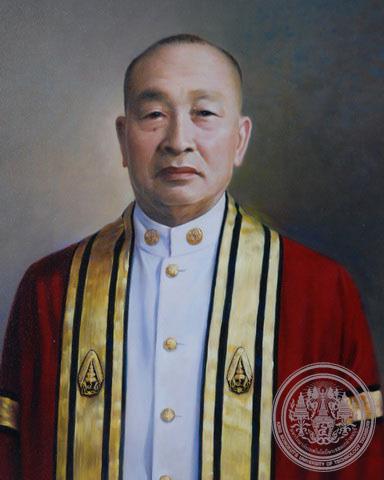
Rear Admiral Chalee Sinthusope
In March 1975, Dr. Prida Vibulsawasdi proposed the establishment of an Energy and Materials Study and Research Office to offer graduate-level education in engineering, focusing on multidisciplinary fields such as energy, materials technology, and nuclear technology. The aim was to conduct research on energy and materials, with an emphasis on applications relevant to the country’s needs.
After review, the Ministry of University Affairs concluded that the King Mongkut’s Institute of Technology Act of 1971 did not provide the authority to establish such an office. If the office were created, it could only conduct research but not offer courses. To offer education, it was necessary to establish a faculty. Therefore, the Institute’s Planning and Development Committee recommended establishing a Faculty of Energy and Materials, in line with the original objectives.
On January 20, 1975, His Majesty the King graciously appointed Rear Admiral Chalee Sinthusope as the 5th Chairman of the Institute Council.
On January 26, 1975, the Royal Decree on the Division of Administrative Units within the Institute was issued, creating faculties, departments, and administrative sections. Dr. Harris Sutabutra was officially appointed as the Dean of the Faculty of Engineering.
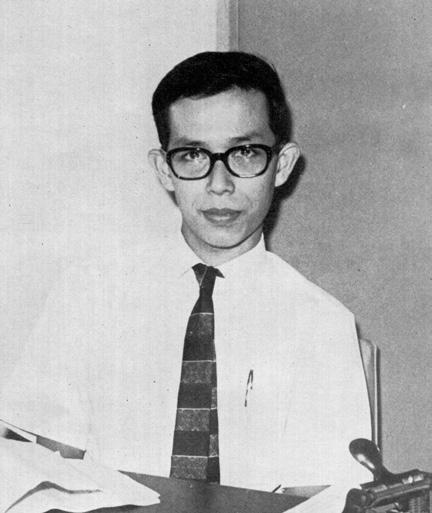
Dr. Prida Vibulsawasdi
In the 1975 academic year, King Mongkut’s Institute of Technology Thonburi began admitting students for its Master of Engineering program in Mechanical Engineering, with the first cohort consisting of 15 students. The Faculty of Engineering also initiated research in the fields of solar energy and wind energy. Additionally, the faculty organized both short-term and long-term training programs, supported by funding from the United Nations Development Programme (UNDP).
On April 2, 1975, the Technical Assistance Program for the Faculty of Industrial Education and Science (THA 72/005) was nearing completion, with some remaining funds. The Chief Technical Adviser, therefore, organized a study and short-term training program in Europe for the coordinators and faculty members of the department. The program was divided into two groups.
- Group 1 participated in a short-term training program and study tour in the United Kingdom, France, and the Netherlands from April 2 to June 1, 1975. The members of this group were:
1. Mr. Phairoj Tiranathanakul
2. Mr. Phajon Kanthachawana
3. Ms. Preaparn Prapitpha
4. Ms. Jariya Panracha
5. Mr. Prayoon Kitpanitchawiset
6. Mr. Suthat Phroanupapakun
7. Mr. Phonrat Laksannianawin
- Group 2 participated in a study tour focusing on technology education, ranging from skilled labor to university level, in France, Germany, the Netherlands, and the United Kingdom, visiting a total of 30 institutions from April 7 to May 2, 1975. The members of this group were:
1. Dr. Haris Sutatabut
2. Mr. Sompong Panyasuk
3. Dr. Preeda Vibulsawasdi
4. Dr. Krittinpong Keeratikorn
5. Dr. Nara Khomnamool
6. Mrs. Klochai Bunyasinh
7. Mrs. Nanta Kohwong
On July 3, 1975, Dr. Phai Boon Hangsapruk was officially appointed as the Vice President of King Mongkut’s Institute of Technology Thonburi.
On October 18, 1975, the third commencement ceremony was held. Professor Sukit Nimanhemind and Mr. Carl Stitzler were awarded honorary Doctorates in Industrial Education. A total of 164 graduates from the Thonburi campus received their degrees during the ceremony.
On December 11-17, 1975, King Mongkut’s Institute of Technology Thonburi (KMITT) organized its second Technology Exhibition. Mr. Sukh Chaisirithaworakul served as the chairman of the organizing committee, with Dr. Haris Suthabutra acting as the chairman of the advisory committee of faculty members. The event received cooperation from embassies, companies, stores, alumni, students, and the general public, just like the first exhibition.
In addition to showcasing works from various departments, the exhibition also highlighted scientific equipment, projects on waste disposal, energy projects, and a project on the “Production and Construction Industry.”
1976
Academic Year 1976
The Faculty of Industrial Education and Science expanded its previous Department of Science and Mathematics into three separate departments: the Department of Mathematics, the Department of Chemistry, and the Department of Physics. The faculty began enrolling students in the Bachelor of Science program, accepting 26 students in the Physics major and 25 students in the Mathematics major. The Chemistry major was set to begin in the following academic year. This program lasted four years and focused on applied science for industrial development. The faculty received a government budget of 15 million baht to construct buildings for offices, classrooms, and laboratories for the Physics and Mathematics departments. An additional 24 million baht was allocated to build classrooms and laboratories for the Chemistry department, replacing the 22-year-old wooden building. The new facilities were expected to be completed by 1981.
October 6, 1976
A riot broke out at Thammasat University, and several students from the institution were arrested. In response, the institution set up a communication and news center to stay updated on the situation involving its students. Staff members were sent to contact the control units at Bang Khen and Nakhon Pathom. The registration department was instructed to send letters to the parents of the detained students to arrange for their release on bail. For those whose parents were unable to arrange bail in time, the Vice President, Deans, and Deputy Deans personally intervened to secure their release.
October 18, 1976
The scheduled ceremony for the royal conferral of degrees, originally set for October 18, 1976, could not be held as planned. However, His Majesty the King graciously approved a new date for the ceremony to be held on March 24, 1977.
1977
March 24, 1977
His Majesty the King graciously presided over the ceremony for the conferral of degrees at the Auditorium of King’s College Institute of Technology, Chao Khun Thahan Campus, Lat Krabang, at 4:00 p.m. Wing Commander Wimol Viriyavith, Mr. Damrong Chonwicharn, and Mr. Shigeyoshi Matsushima were awarded honorary Doctor of Engineering degrees. A total of 293 graduates from the Thonburi campus received their degrees during the ceremony.
Academic Year 1977
The Institute began accepting students for the Master of Engineering program in the Energy Technology branch, with 14 students, and the Civil Engineering branch, with 15 students. The Institute also initiated a quota system for admitting students to the Bachelor of Engineering (B.Eng.) and Bachelor of Science (B.Sc.) programs from regional areas, with selection based on universities in those regions. The Department of Language and Social Sciences proposed the “English for Science and Technology” project and sought assistance from the Colombo Plan. The United Kingdom, through the British Council, provided support by sending Mr. Andrew Dunlop to help design the curriculum, prepare course content, and train faculty on teaching methods starting in September 1976.
This year, the Institute began publishing the KMITT Research and Development Bulletin. Dr. Sawat Tantarat was appointed as the first editor.
- Canadian Volunteers
1) Mr. Frank Summerville – Department of Civil Engineering
2) Mr. Sangwan Panmuk – Department of Industrial Engineering
3) Mr. Kenneth Cooper – Department of Mechanical Engineering
4) Mr. David Ford – Department of Chemistry
5) Mr. Ralph Pynn – Department of Electrical Engineering
- British Volunteers
1) Mr. Peter Friend – Department of Electrical Engineering
2) Mr. James Stockwell – Department of Industrial Engineering
- American Volunteers
1) Mr. Lucy Locorcaro – Department of Language and Society
2) Dr. Conrad Weiffenbach – Department of Physics
3) Mr. Joe Cummings – Department of Language and Society
4) Mr. N.C. Gordon – Department of Language and Society
5) Mr. George Thompson – Department of Chemical Engineering
- German Volunteer
1) Mr. Rudolf Konzelmann – Department of Industrial Engineering
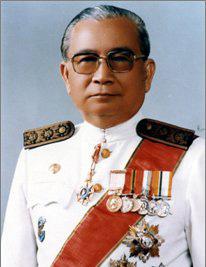
Professor Dr. Prasert Na Nakhon
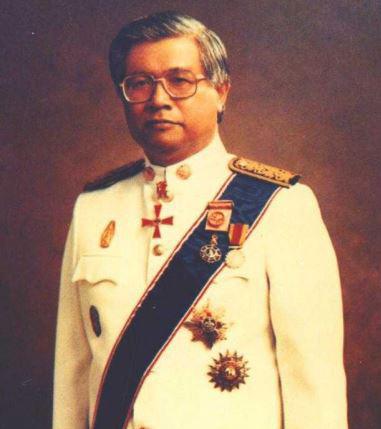
Professor Boonyasak Jaijongkij
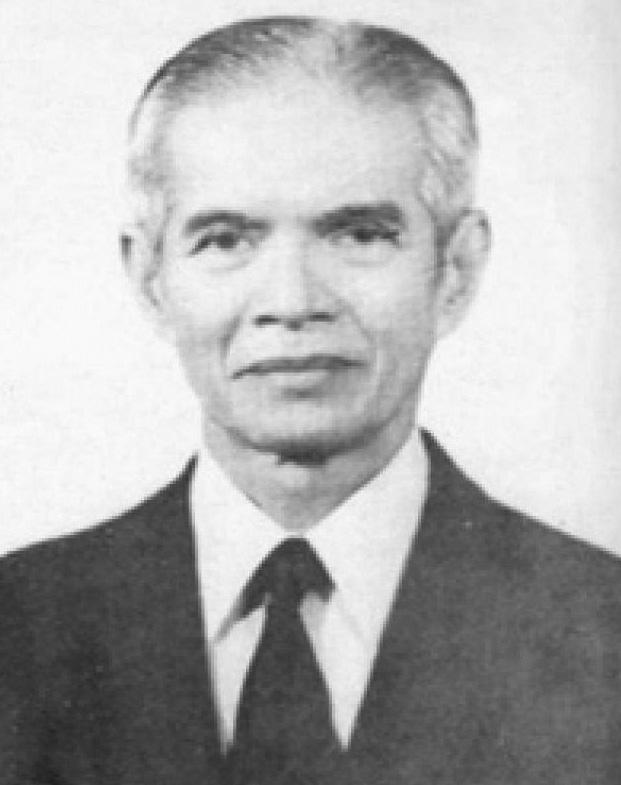
Professor Jamrat Chaiyaphong
1981
January 13, 1981
Rear Admiral Chalee Sindusophon, Chairman of the Institute’s Council, passed away. The Institute’s Council decided that Professor Prasert Na Nakhon would temporarily assume the duties of the position.
April 20, 1981
The Department of Languages organized an Inservice Training Workshop for English Teachers from April 20 to May 19, 1981. A total of 82 English language instructors from other campuses, as well as technical colleges and schools across the country, participated in the training.
October 1, 1981
Professor Phongsak Worasunthorosot, the President of the Institute, tragically passed away due to an accident.
November 3, 1981
His Majesty the King graciously appointed Professor Boonyasak Jaijongkit as the new President of the Institute.
December 12, 1981
The Institute organized an academic seminar on “Solar Energy and Applications,” marking the first seminar in the series on alternative energy and its applications, in collaboration with the Thai-Japan Technology Promotion Association. The event took place at the Association’s seminar room from December 12-16, 1981. The seminar included lectures from experts, presentations of research and development findings, discussions among participants, and a visit to the solar energy research and development projects off-campus at the Thonburi campus. A seminar report was published and distributed for further dissemination.
The King’s College Technology Act (No. 3) B.E. 2522
Published in the Royal Gazette, Volume 96, Issue 55, Pages 36-46. This Act is most aligned with the management structure of the Thonburi campus.
December 20, 1978
His Majesty graciously appointed Professor Jamrat Chaiyapong as the 7th President of the Institute’s Council.
1979
Academic Year 1979
- The institution’s first building was demolished to make way for the construction of a new Chemistry building.
- The Faculty of Energy and Materials was established, focusing on graduate-level education, research, and development in energy technology and related fields.
December 7, 1979
Her Royal Highness Princess Chulabhorn Walailak, the Royal Highness the Princess Consort, presided over the opening of the 3rd Technology Exhibition and the 20th Anniversary celebration of the Thonburi Campus.
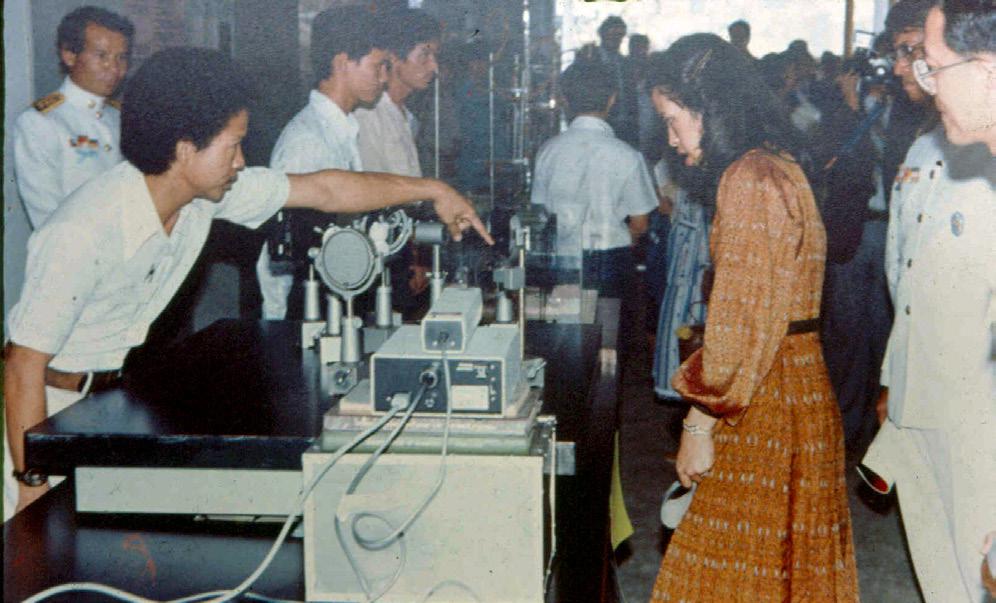
1980
On January 16, 1980, the Institute proposed the establishment of the Educational Services Division and the Library Office.
On September 25, 1980, the Institute issued regulations regarding the admission of external individuals for training in the Faculty of Engineering. This training would allow participants to use the completion of the program as part of their application for an engineering practice license.
In October 1980, the National Energy Office and USAID supported Thonburi College in implementing a project to develop the use of solar energy (Solar Process Heat) in rural areas, with a project timeline of 4 years.
On October 18, 1980, the institution presented an honorary Doctor of Science degree to His Royal Highness Crown Prince Maha Vajiralongkorn, and an honorary Doctor of Industrial Education degree to Her Royal Highness Princess Maha Chakri Sirindhorn, Princess Royal of Thailand.
On December 31, 1980, the Royal Decree on the Organization of the Institute’s Administrative Divisions, B.E. 2523, was published in the Royal Gazette, Special Edition, Volume 97, Issue 208 (pages 1-3).
1981
On March 12, 1981, the University Bureau Committee decided to establish the library of the Thonburi campus as a departmental unit under the Office of the Vice President. This decision was published in the Royal Gazette, Volume 98, Issue 205 (Special Edition), page 18, effective from November 26, 1981.
On July 2, 1981, the University Bureau issued a notification regarding the reorganization of the administrative divisions within King Mongkut’s Institute of Technology. This announcement was published in the Royal Gazette, Volume 98, Issue 117 (Special Edition).
In July 1981, the Thonburi campus participated in the ASEAN project on the utilization of food and agricultural waste materials. It also became the main agency in Thailand responsible for managing the cooperation project between ASEAN and Australia.
On August 13, 1981, a meeting of the Institute’s Council was held to consider nominees for the position of Rector for the upcoming term. This marked the beginning of a clear administrative crisis at King Mongkut’s Institute of Technology.
1982
On February 2, 1982, the Institute approved the establishment of the Institute’s Archive within the library at the Thonburi campus.
From February to April 1982, the Institute Council considered that the conflicts and violent incidents were a result of the structure of the Institute, which included three colleges with different histories, philosophies, and educational management approaches. Therefore, the Institute Council proposed four models for restructuring the Institute’s administrative system to the University Affairs Board for approval.
On April 14, 1982, and August 3, 1982, the Cabinet approved the principle of the draft Institute Act based on Model 2. This model proposed the establishment of three separate institutions, each with its own legal status, rector, and governing council. The majority of administrative tasks would be completed at the institutional level.
On September 7, 1982, the establishment of the Scientific Instruments Center for Standards and Industry was announced.
In the academic year 1982, the Master’s degree program in Biotechnology was launched in the Faculty of Energy and Materials, along with the Bachelor of Science program in Microbiology in the Faculty of Industrial Education and Science.
On October 22, 1982, a committee was appointed for the construction project of the King Rama IV Memorial to be erected in honor of the 180th anniversary of His Majesty King Mongkut’s birth (October 18, 1987) and the 25th anniversary of the establishment of the Thonburi campus (February 4, 1985).
On December 8, 1982, Her Royal Highness Princess Maha Chakri Sirindhorn graciously presided over the opening of the 4th Technology Exhibition. She also inaugurated the new building of the Faculty of Energy and Materials, the Department of Chemistry building, and the library.
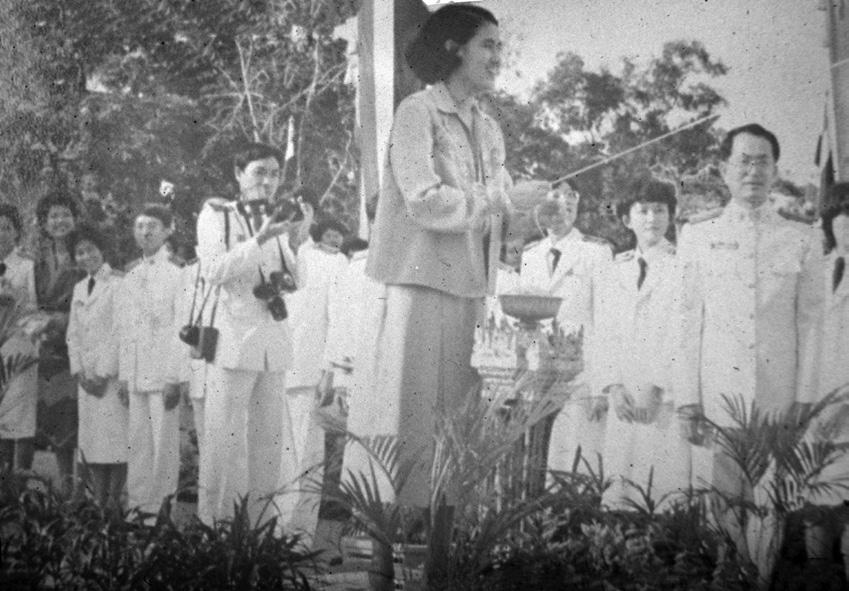
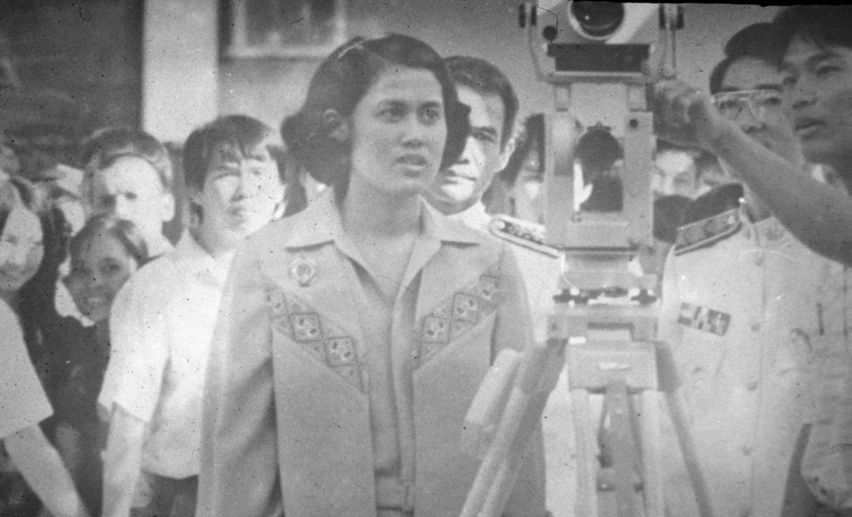
1983
In the academic year 1983, the Master of Engineering (M.Eng.) program in Chemical Engineering was launched in the Department of Chemical Engineering.
On July 1, 1983, the University Council issued the announcement regarding the division of administrative units at the Institute (Announcement No. 4), which established the Educational Services Division under the Office of the Vice President at the Thonburi campus.
On July 4, 1983, the Institute conducted its first-ever dean selection process for the Faculty of Engineering and the Faculty of Industrial Education and Science.
On August 4, 1983, the University Bureau approved the establishment of the Department of Mechanical Education, Department of Electrical Education, and Department of Microbiology within the Faculty of Industrial Education and Science.
On August 22, 1983, the Institute Council approved the resignation of Professor Boonyasak Jaijongkit from the position of President and appointed the Vice Presidents of the various campuses to serve as Acting Presidents, each for a period of 3 months.
On September 6, 1983, the Cabinet instructed that the draft Act for the Institute, which had been reviewed by the Council of State, be sent to the Ministry of University Affairs and the National Education Commission for joint consideration regarding the potential impact on universities with multiple campuses.
On October 1, 1983, Mr. Alan G. Waters, a British expert, was assigned to the Department of Language and Society as an MA Advisor under the Colombo Plan for a period of 4 years.
On November 10, 1983, a major flood, the worst on record, occurred across the campus. Since mid-October, several training workshops were severely affected, including Civil Engineering Workshop 1, Industrial Workshop 2, and Workshop 3. Personnel had to travel to work by boat due to the flooding.
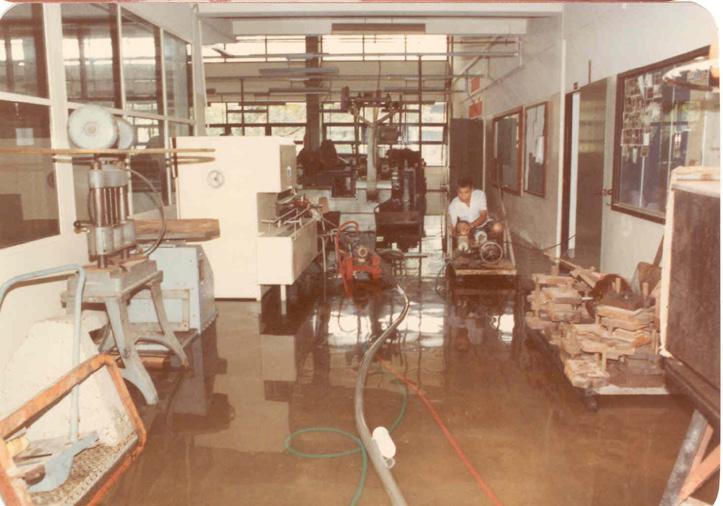
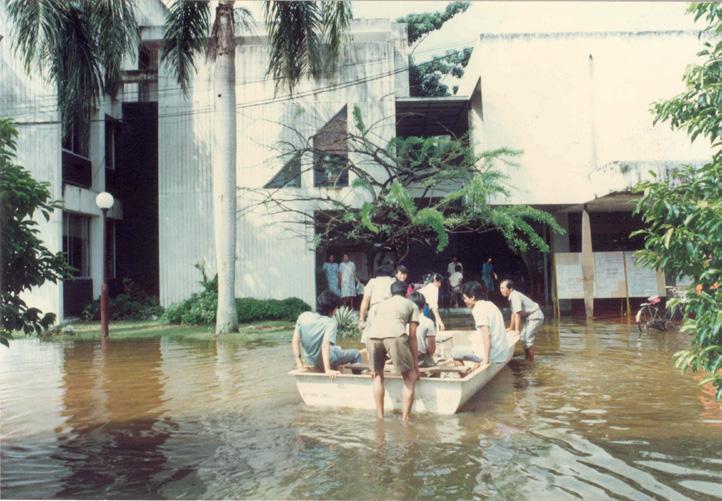
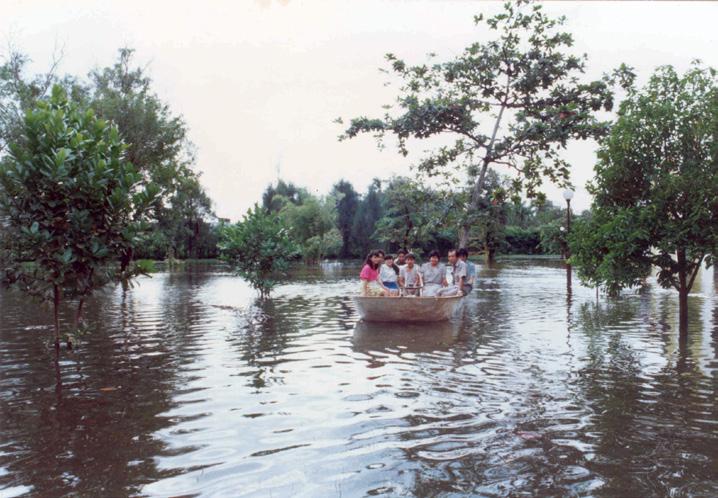
On December 20, 1983, the Cooperative Shop of King Mongkut’s Institute of Technology Thonburi (KMITT Cooperative Shop Co., Ltd.) was officially registered and began its operations on April 18, 1984.
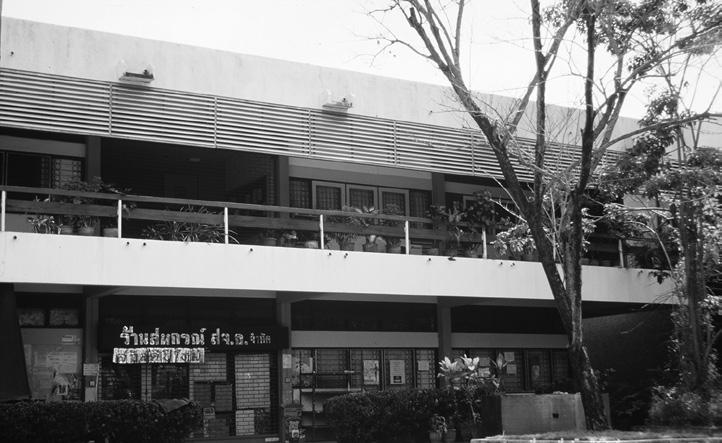
1984
On January 11, 1984, the Institute approved the use of the Chemical Engineering building as the office for the Royal Project on Processed Foods and the Royal Development Project. Additionally, a storage facility for the project’s products was to be constructed. His Majesty the King graciously expressed his satisfaction with the support and cooperation received from the Institute for these projects.
On January 24, 1984, the National Education Commission and the Office of the University Affairs Committee jointly submitted their recommendations to the Cabinet regarding the structure and management system of the Institute, as outlined in the draft Bill that had been reviewed by the Law Reform Committee. The Bill was further reviewed on two occasions, on April 17, 1984, and July 24, 1984.
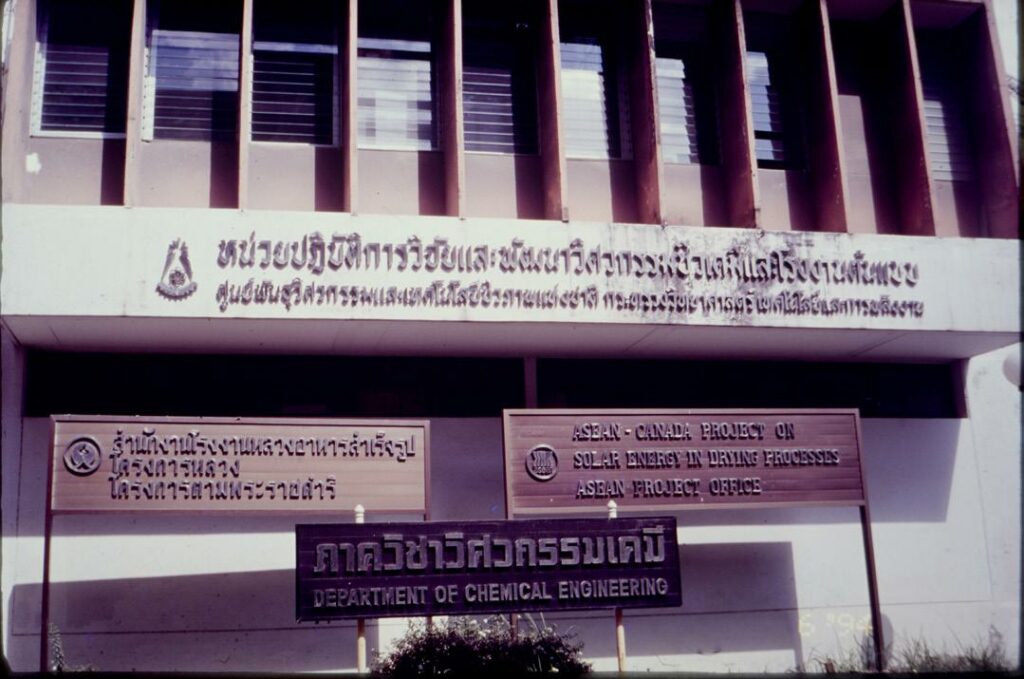
In May 1984, faculty members of King Mongkut’s Institute of Technology participated as members of the policy committee, executive committee, and academic committee of the National Center for Genetic Engineering and Biotechnology.
In the 1984 academic year, the Master of Arts program in Applied Linguistics (English for Science and Technology) was introduced in the Department of Language and Social Sciences. Additionally, the updated Bachelor of Engineering program was implemented for new students.
On June 26, 1984, an agreement was signed for a research project on grain preservation with Australia, valued at 51,000 dollars, with a duration of 3 years.
In August 1984, the Australian government provided assistance in establishing the ASEAN-CODEX Coordinating Center for food standards and the ASEAN Energy Secretariat at the Chemical Engineering Building.
On October 11, 1984, the Secretariat of the Cabinet informed that His Majesty King Bhumibol Adulyadej had granted royal permission to construct a statue of King Rama IV (King Chulalongkorn) as requested by the Vice President of the Thonburi Campus.
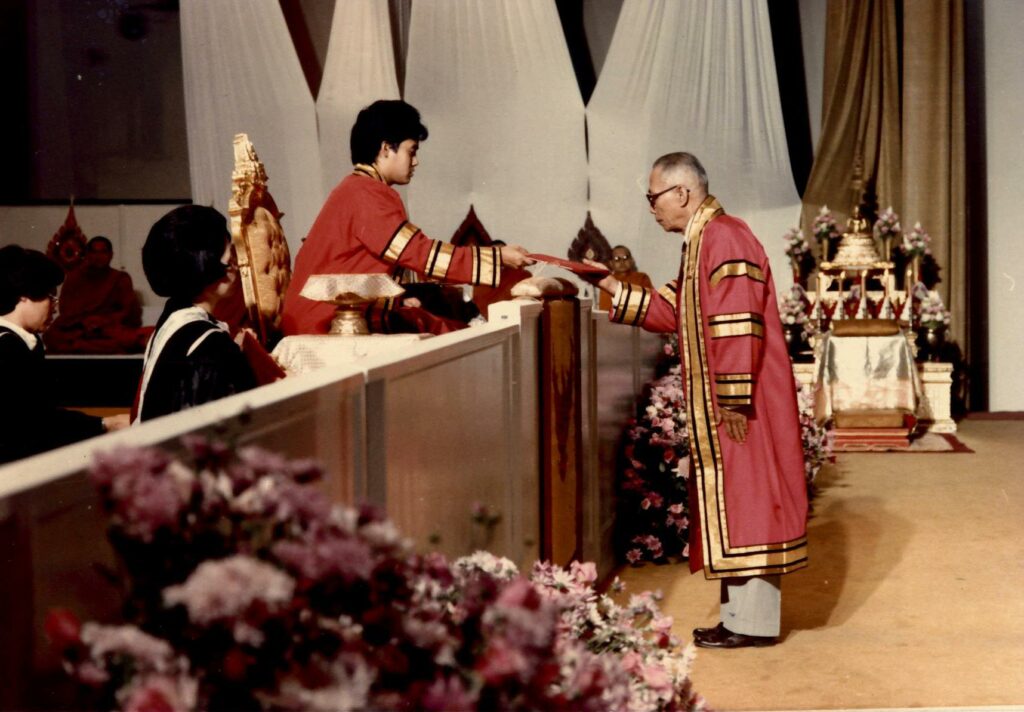
On October 18, 1984, Professor Prapha Prajak Suphanimit, the first administrator of the institute, was awarded an honorary Doctor of Industrial Education degree.
In November 1984, a research and development project was launched to utilize and treat wastewater from tapioca starch factories. The project received a 4 million Baht grant from the National Center for Genetic Engineering and Biotechnology, with a duration of 3 years.
On December 25, 1984, a contract was signed for the creation of the statue of King Rama IV (King Mongkut). The sculptor was approved by the Monument Construction Committee of the Fine Arts Department.
1985
From February 2-8, 1985, the Ad-Hoc Committee, chaired by Professor Ubon Chantakamol, organized the 25th Anniversary celebration of the establishment of the Thonburi campus. The event marked the official first fundraising campaign to support the construction of the King Mongkut Memorial Monument.
On March 4, 1985, the Secretary-General of the Council of State announced that the draft of the Institute Bill had been reviewed and completed. It was then submitted to the Prime Minister’s Office for further consideration and action.
On April 16, 1985, the Cabinet approved the draft of the Institute Act, which had been reviewed and amended by the Council of State. The name of the draft bill was changed, and some principles and reasons were revised. The bill was then submitted to the Committee for Coordination with the House of Representatives for further consideration before being presented to both the House of Representatives and the Senate for further review. The draft bill was included in the regular agenda as item number 141.
On May 13, 1985, the Committee for Coordination with the House of Representatives resolved to submit the draft bills for the King’s College of Technology, King’s College of Technology Thonburi, and King’s College of Technology Phra Nakhon. It also included the draft amendment to the Revolutionary Council Announcement No. 216, dated September 29, 1972, to the House of Representatives for further consideration.
In the 1985 academic year, the Institute Council approved the Faculty of Energy and Materials to offer graduate-level courses in the field of Technology Management.
On June 20, 1985, during the 10th/1985 session (regular session) of the House of Representatives, a vote was passed to approve the principles of the draft Act on the Institute as proposed. A special committee of 25 members was also established to review the proposal further.
On July 11, 1985, the House of Representatives approved the draft Act on the Institute in its second and third readings with no objections. The draft was then forwarded to the Senate for further consideration in accordance with the Constitution of the Kingdom of Thailand.
On July 12, 1985, during the 10th session of the Senate (ordinary session), the motion on the draft Act on the Institute was rejected by a vote of 51 against and 31 in favor, with a number of senators abstaining from voting.
On July 25, 1985, Mr. Pichai Phanthawong began the construction of the base platform for the King Rama IV Memorial.
On August 7, 1985, the Committee for the Memorial Construction, under the Fine Arts Department, conducted a final review of the clay model of the statue.
On September 1, 1985, the Alumni Association organized a charity bowling event to raise funds for the Royal Memorial Statue project.
On September 12, 1985, His Majesty the King graciously called for a special session of the National Assembly. Mr. Uthai Phimchaichan, Speaker of the House of Representatives, proposed that the assembly reconsider the draft of the King Prajadhipok Institute Act before considering the budget for the fiscal year 1986. The meeting voted to confirm the original draft, thereby approving the bill by the National Assembly.
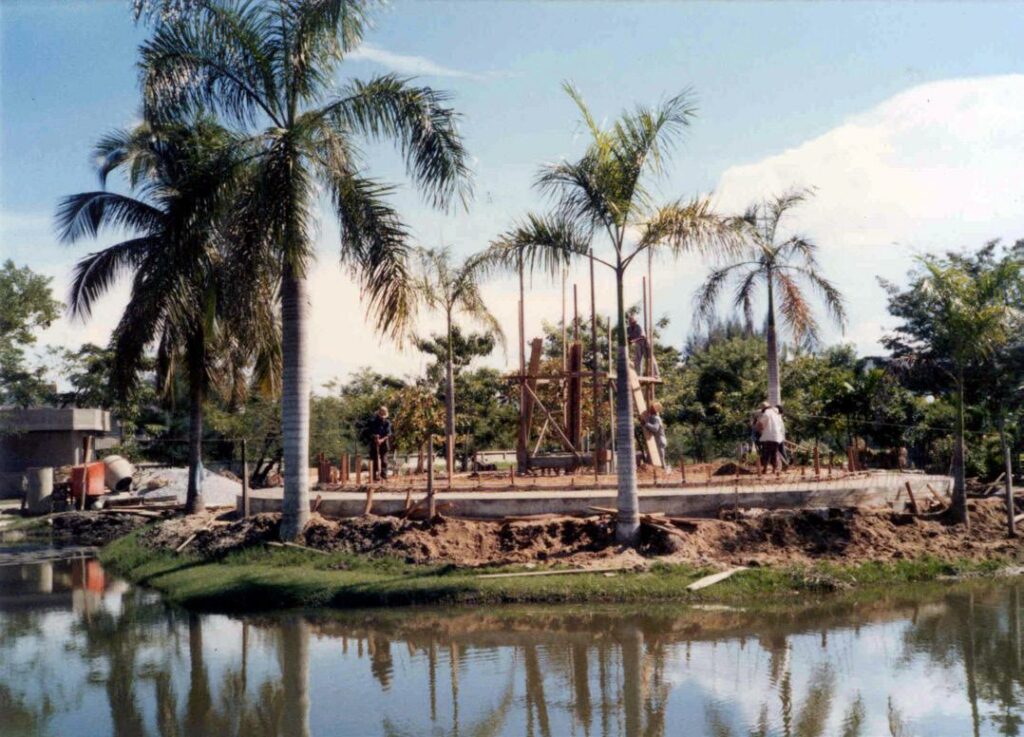
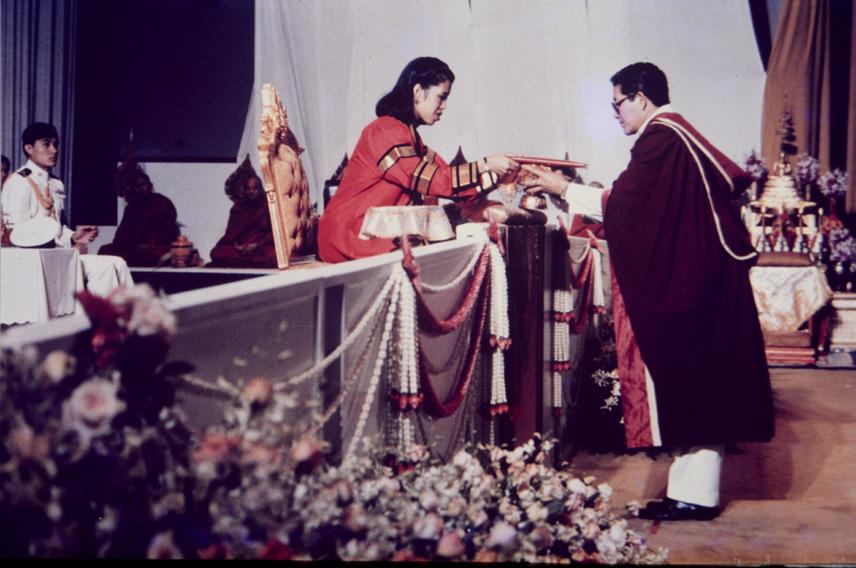
On September 14, 1985, Professor Nontarit Serophat and his team conducted a ritual to consecrate the construction of the King Rama IV Monument.
On September 16, 1985, Mr. Ukrit Mongkolsnawin, President of the Senate, informed the Senate meeting that the House of Representatives had reaffirmed the original draft of the Act, Article 129, regarding King Mongkut’s Institute of Technology. This was a result of the merging of colleges, which were then separated into three independent institutions.
On October 18, 1985, the Institute respectfully presented an honorary Doctor of Science degree in Industrial Chemistry to Her Royal Highness Princess Chulabhorn Walailak, the Princess Royal.
On November 4, 1985, Her Royal Highness Princess Maha Chakri Sirindhorn presided over the cornerstone laying ceremony for the base of the King Rama IV Monument and performed the casting of the royal statue of King Rama IV at 09:09 AM.
